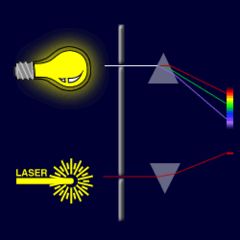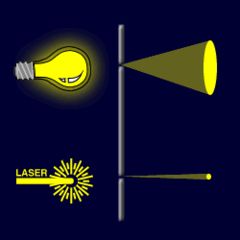2. General Information
The beam of a laser is tightly bundled light. The light beams move almost parallel to each other. This is why a laser beam appears as a thin ray of light even over a great distance. This is also why the intensity of the beam (power per unit area) remains almost constant along the whole length of the beam.
A laser light is produced by applying the principle of «Light Amplification by Stimulated Emission of Radiation» –
from which the acronym LASER is derived. In this process, a large collection of excited state atoms is created, atoms with higher energy electrons. The electrons of some of these atoms remain sitting at this excited state until stimulated to fall to a lower energy level in turn releasing some energy. This emitted energy comes in the form of light energy, the laser beam.
Properties:

monochromatic |

low emittance |
Further properties:
High energy density, spatially coherent and in phase
|
